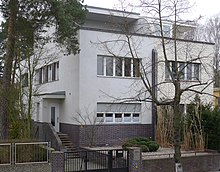Rudolf Frankel

Rudolf Fränkel (born June 14, 1901 in Neisse , Upper Silesia , † April 23, 1974 in Cincinnati ) was a German architect and university professor .
Life
Rudolf Fränkel was born in Neisse in 1901 as the son of the architect Louis Fränkel and his wife Ida in a middle-class Jewish family. After graduating from high school due to the war , he studied at the Technical University of Charlottenburg from 1918 to 1922 . In 1921 he married the doctor's daughter Eva Tarrasch, from 1922 to 1924 he worked for Richard Riemerschmid in Munich . In 1924 he opened his own office in Berlin . His first major order was the Atlantic Garden City in Berlin-Gesundbrunnen at the Gesundbrunnen S-Bahn station , an ensemble that is now a listed building. Further residential buildings, residential complexes and entertainment venues in Berlin and the surrounding area followed. In 1925 he became a member of the Association of German Architects . The Lichtburg , which completed his development plan for the Atlantic Garden City, was one of the first sound film cinemas ; this also included a hotel, restaurants and dance halls.
Fränkel's designs and buildings were recognized early on as role models for the avant-garde and were published in important contemporary architecture publications such as Wasmuth's monthly magazine for Baukunst , Bauwelt or Das Schöne Heim . His metropolitan amusement buildings were characterized by their impressive light architecture.
After the handover of power to the National Socialists and the persecution of Jews and avant-garde artists, Fränkel emigrated to Bucharest in the summer of 1933 , where he also designed an important cinema, the “Scala”, as well as other houses and apartment buildings until he moved to London in 1937 emigrated. There Fränkel continued his work by creating important factory and residential buildings, which today represent exemplary buildings of "Continental Modernism" in Great Britain.
In 1950 Fränkel was appointed to the architecture faculty at Miami University in Ohio , where he initiated one of the first urban planning programs in the United States in 1954. When it ended in 1968, Fränkel gave up teaching. Until 1974 he lived in Oxford, Ohio ; his estate was donated to the Canadian Center for Architecture in Montreal .
buildings
- 1924–1928: Atlantic Garden City in Berlin-Gesundbrunnen, Behmstrasse, Bellermannstrasse, Spanheimstrasse
- 1926: Residential development on Emser Strasse 14-17a in Berlin-Wilmersdorf
- 1926–1928: Levy house in Bad Saarow , Silberberger Straße 29a
- 1927: Honey residential complex in Berlin-Gesundbrunnen, Bellermannstrasse 72-78
- 1927–1929: “Lichtburg” cinema in Berlin-Gesundbrunnen
- 1927–1930: One and two-family houses in the garden city Frohnau in Berlin-Frohnau , Am Pilz, Schönfließer Strasse
- 1928: Ruhr bridge in Schwerte-Westhofen (destroyed)
- 1929: Two-family house in Berlin-Dahlem , Warnemünder Straße 28a / b
- 1930: Apartment house in Berlin-Halensee , Grieser Platz
- 1930–1931: “Leuchtturm” restaurant in Berlin-Mitte, Friedrichstrasse 138
- 1930–1932: Residential development at the Schöneberg City Park in Berlin-Schöneberg
- 1931–1932: Stern residential building in Schmolz near Breslau
- 1932–1933: Reconstruction of the Albert Schumann Theater in Frankfurt am Main (destroyed in the war in 1944, ruin torn down in 1960)
- 1933–1934: Pop house in Bucharest, Caragiale 9
- 1933–1935: Adriatica Asigurarea building in Bucharest
- 1934–1936: Factory building of a silk weaving mill near Bucharest
- 1935–1936: Teatrul de Comedie (Comedy Theater) in Bucharest
- 1935–1937: “Malaxa” apartment building in Bucharest
- 1935–1937: “Scala” cinema in Bucharest
- 1936–1937: Villa Flavian in Bucharest, Serg Gheorghe Militaru
- 1937–1938: Rachwalsky House, Home County
- 1946–1947: Factory building of Suflex Ltd.
- 1946–1948: Factory building of the clothing factory Sotex Ltd.
literature
- Gerwin Zohlen (Ed.): Rudolf Fränkel, the garden city Atlantic and Berlin. Verlag Niggli, Sulgen 2006 ISBN 3-7212-0605-3
- Gerardo Brown-Manrique: Rudolf Fränkel and New Building. Work in Germany, Romania and the United Kingdom. Wasmuth, Berlin 2009 ISBN 978-3-8030-0695-0
Web links
- Rudolf Frankel. In: arch INFORM .
- Rudolf Fränkel in the archive of the Academy of Arts, Berlin
- Fränkel in the database Architects in Exile 1933 - 1945 , Karlsruhe Institute of Technology , by Sonja Grunow, 2020
Individual evidence
- ↑ Wasmuth's monthly magazine for architecture , issue 11/1927
- ↑ Landhaus L. in Saarow by the architect Rudolf Fränkel, Berlin. In: The beautiful home. 1st year (1930), pp. 209-213.
- ↑ Landhaus L. in Saarow by Rudolf Fränkel. In: The art. Volume 31, No. 6 (1930), pp. 144–149.
- ^ The beautiful home , No. 10 (from July 1933).
| personal data | |
|---|---|
| SURNAME | Frankel, Rudolf |
| ALTERNATIVE NAMES | Frankel, Rudolf |
| BRIEF DESCRIPTION | German architect and university professor |
| DATE OF BIRTH | June 14, 1901 |
| PLACE OF BIRTH | Neisse Upper Silesia |
| DATE OF DEATH | April 23, 1974 |
| Place of death | Cincinnati , Ohio, USA |


